The other day, in an attempt to make you more comfortable with the idea of using silk thread for embroidery, we chatted about hand embroidery thread made from spun silk.
When it comes to the stitching experience, spun silk is very similar in many ways to stranded cotton embroidery floss, so it makes a great thread for beginners to start using silk.
But there’s another type of silk fiber that’s made into embroidery thread, called filament silk. Today, we’re going to talk about twisted filament silk, and then, down the road, we’ll chat about flat filament silk.
When compared to spun silk, filament silk provides a slightly different stitching experience. But the experience is not the only thing that’s different about filament silk – so let’s take some time to explore the stuff!
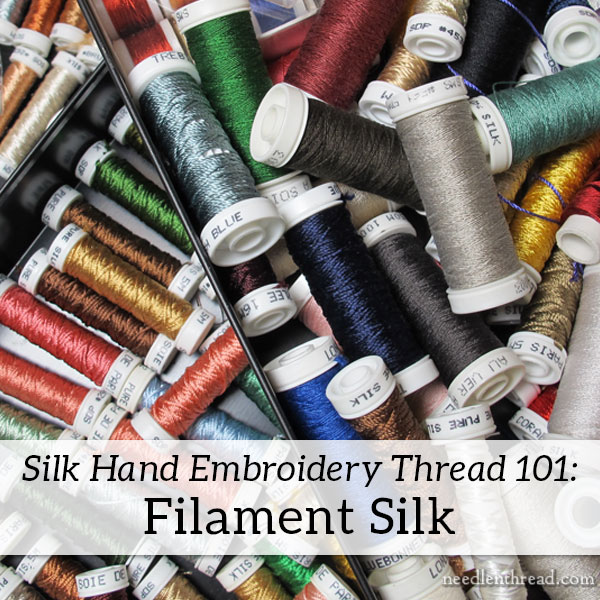
Filament silk differs from spun silk in a number of ways. Let’s look at how you can tell the difference between the two.
How to Tell the Difference between Spun & Filament Silk
The most obvious way is in the look of filament silk. In general, filament silk is glossy.
Spun silk is made from broken cocoons and leftovers and spun into a thread much in the same way that wool or cotton is spun into thread. It has a luster to it – a nice, soft shine.
Filament silk, on the other hand, is not “spun” from fibers. It is the fiber itself, reeled straight off the cocoon, and hence, it’s sometimes referred to as “reeled” silk.
100% filament silk has more than just a soft luster to it. It has a downright shine.
If you’re trying to determine whether the silk you’re using is spun or filament, the first thing to do is to look at it. Spun silk will have a soft luster, while filament silk has a high sheen. However, this isn’t always a fool-proof way of knowing, with certainty, whether you’re working with spun or filament silk.
Sometimes, a twisted filament silk will not have quite as a high a sheen as a flatter filament silk, or a less twisted filament silk.
So if you can’t tell by looking, you can try picking. Try to pull the thread apart. Spun silk is weaker than filament silk, and will pull apart in a kind of shreddy way if you pick at it closely.
Filament silk is much stronger, and it’s much more difficult to pull apart! It definitely won’t pull apart easily in small pieces, because the individual strands that make up the thread are long and strong.
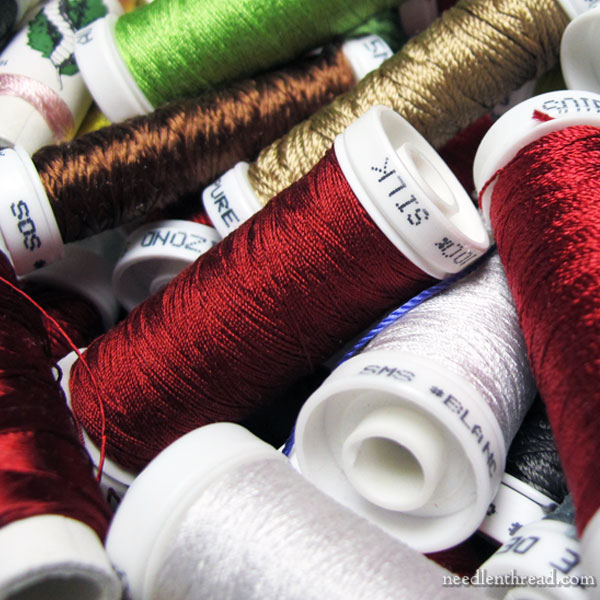
Filament silk embroidery threads are made up of many fine strands of reeled silk (in Japanese embroidery, these individual filaments are called “suga”) that are combined into the thread weight.
Filament silks can be flat or twisted. In the scheme of things, I think flat silk is more difficult to work with, so we’ll talk about twisted filament silk today and work our way up to flat silk.
Twisted Filament Silk
Twisted filament silk comes in all kinds of weights and types and twists! Many types are made for machine stitching as well as hand stitching, and some are made only for hand stitching.
The following are different types of twisted filament silk that I’m familiar with and have used. I don’t know every single thread on the embroidery market, though, so I’m just mentioning the ones I have worked with. I’m sure there are others out there. If you’ve worked with twisted filament silks and you have a favorite that’s not mentioned, you’re welcome to mention it in the comments below.
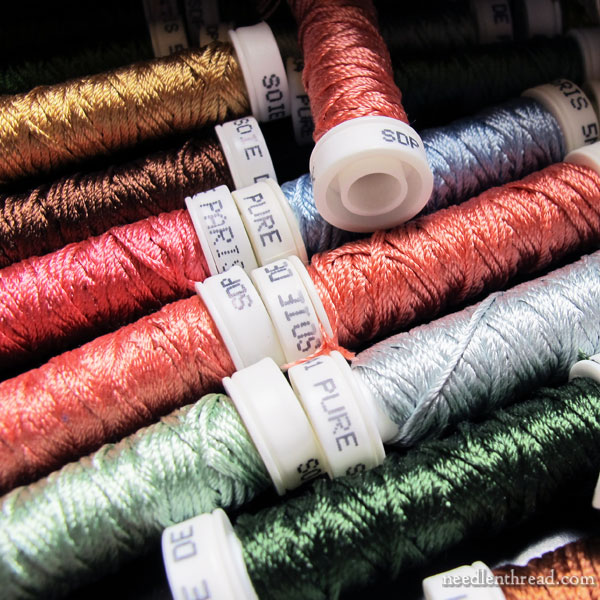
1. Au Ver a Soie
Au Ver a Soie twisted filament silks include Soie de Paris, Soie de Gobelin, and Soie Perle. These silk products come on spools here in the States (in Europe, Soie de Paris comes in a twist), and in the US, you can find them through any needlework shop that carries goods from Access Commodities.
Au Ver a Soie’s silks, again, are the Gold Standard on the market. You won’t find thick or thin spots in the same thread or variations in the twist (i.e. some areas tightly twisted, others loosely twisted). You also won’t find a lot of slubs (little bunches of silk fibers that make a bump in the thread). They are practically perfect threads, and it’s obvious that they undergo careful oversight and scrutiny during the manufacturing process.
You may find this article on working with Soie de Paris and other filament silks helpful, when considering stitching with these silks.
Soie de Paris is a fine, softly twisted, 6-ply filament silk. I used it on this Tudor-style rose and on this Mission Rose project. It has a high sheen. The silk is “stranded” in the same way that cotton floss is – that is, several strands make up the whole thread that comes off the spool, and you separate the strands to use them. You can use one tiny strand or more in the needle at once. It comes in 77 colors.
Soie Perle is a more tightly twisted silk thread, about the weight of a fine buttonhole silk. It is used straight off the spool in the one thread and is not separated. It can be used for decorative stitching, line stitches, crazy quilting, quilting, and other embroidery applications where a twisted, fine perle thread is desirable. It comes in 365 colors.
Soie Gobelin is a fine, tightly twisted silk, used straight off the spool in one strand. It has many hand embroidery applications, but I use it mainly for outlining and detail work in silk embroidery. For example, I used it as the outlines in this Tudor-style rose. It can be effectively used as a couching thread. It comes in 104 colors.
If you’d like to see these threads a little closer and read more about them, this article on comparing twisted silks has a little more information on them. The pictures are old and need re-doing, but the information is still solid!
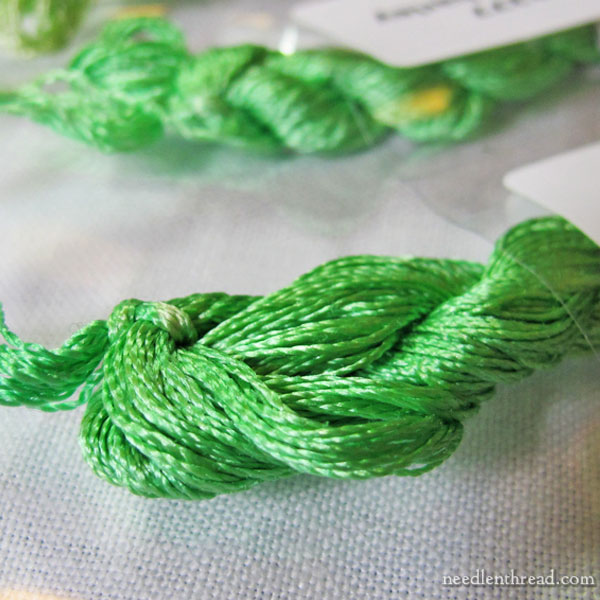
2. The Silk Mill
The Silk Mill, a company in France that dyes Chinese silk, offers a huge range of colors (700!) in softly twisted filament silk that’s reminiscent of the silk floss used in the early 1900’s in Society Silk embroidery and in ecclesiastical embroidery.
Because of the vast color and shade range that The Silk Mill offers, their threads are a good option for needle painting with a softly twisted filament silk.
The thread comes in twisted skeins, which require a little care when opening up and preparing for stitching. It also tends to be a little kinky and unruly. If you’re only familiar with stitching cotton, this can be problematic, but with a little practice, you get used to it!
3. Needlepoint, Inc. Silk
Needlepoint Inc silk is described as being reeled silk, not spun.
I’ve worked with this thread a little bit, and I always thought it was a spun silk. When I was told it is a reeled silk, I was rather taken aback, so one of these days, I’m going to examine it and re-evaluate my earlier perceptions of it.
It comes in 8-ply 5 meter skeins, so you separate it into individual strands and use one or more in the needle at once.
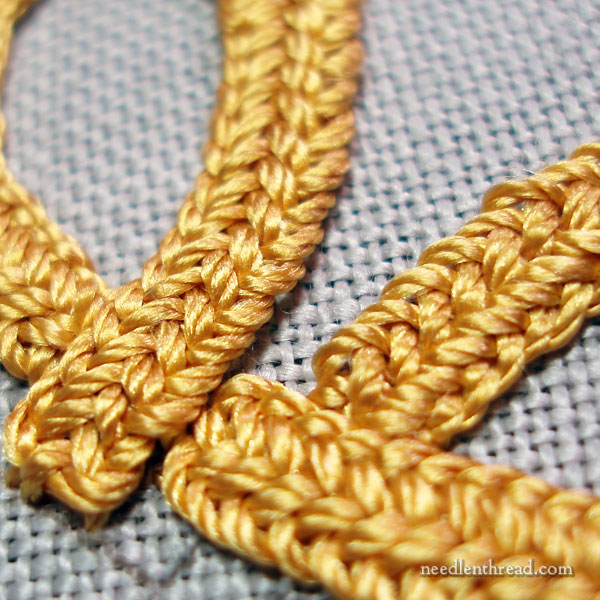
4. Trebizond
Trebizond is a tightly twisted three-ply filament silk that’s quite thick and extremely lustrous, rich, buttery, and beautiful. It’s probably more commonly used in needlepoint than in hand embroidery, but it can be effectively used in hand embroidery applications.
I’ve used Trebizond to good effect, working the plaited braid stitch. It makes a luxuriously thick, heavy braid – but the stitch is a thread hog, so it takes a lot of thread!
You can read about my experiment with plaited braid in Trebizond here.
Trebizond is not meant to be taken apart – it’s used straight off the spool. But it is constructed from three plies of flat silk twisted together, and those three plies can be separated. What you’ll end up with is a lustrous flat silk that’s quite wavy. (I discuss this in this article comparing filament silks.)
You can actually stitch with that wavy flat silk. It makes a beautiful laid satin stitch that can be couched over, and the waves in the silk play off the light beautifully. I’ll work up a sample to demonstrate this one of these days!
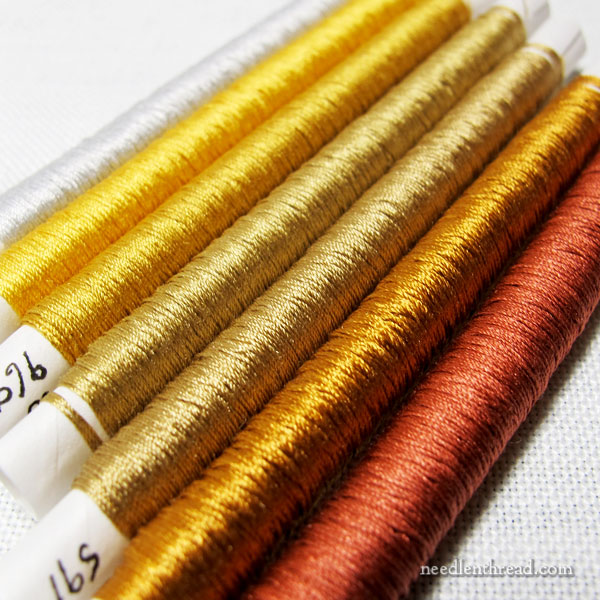
5. Mulberry Silks
Mulberry Silks is a company in the Cotswolds in England. They offer some amazing palettes of twisted silks – I just love their color collections!
I’ve not stitched with all their threads, but I’ve tried some, and I’ve written about them here.
They’re one of those threads I’d like to work a little more with, but they’re a bit of an investment. The ones I have tried stitch up nicely. In their connoisseur packages (which is where you’ll find those gorgeous color palettes), the thread comes in three weights – fine, medium, and heavy – and in matte and shiny. I suspect the matte is a spun silk and the shiny is filament. Again, I haven’t played much with them, but the ones I have tried, I liked!
Their threads can be used for hand stitchery and also for mixed media and the like. Because of the varying weights and textures, there’s a lot of scope for playing!
Resources
If you’re looking for any of these silk threads, here are some online resources. I’m not super familiar with which stores outside the US carry some of these threads, so if you know of any and you want to leave a comment below, feel free!
Au Ver a Soie
In the US, Au Ver a Soie’s silks can be found online at Needle in a Haystack, where they stock the whole line, and anything they don’t have in stock, they can special order. Their website offers an easy shopping experience, and you can actually see the individual spools and colors of threads.
Thistle Threads carries collections of historical color groupings in different Au Ver a Soie silks.
You can also special order Au Ver a Soie threads through Nordic Needle.
And of course, you can check any local needlework shop that carries extensive lines of threads. They may have it, and you can see it in person!
Silk Mill
For silk threads from The Silk Mill, visit their website! They are located in France.
Needlepoint Inc
These silks are available pretty widely in different online shops. You can find them directly through Needlepoint Inc here, or you might check here at 123-Stitch, as the prices are a bit better.
Trebizond
Trebizond is available here through Nordic Needle.
Trebizond is also available through Needle in a Haystack, here.
And, if you happen to have a local needlepoint store, check there! It’s one of those threads you should see in person and maybe try first, before investing in a lot of spools. But definitely worth trying! You can do intriguing things with it!
Mulberry Silks
Mulberry Silks are available directly through their website, out of the UK.
For a very satisfying color experience, browse their connoisseur packets!
Further Discussions about Silk Coming Up!
Next, we’ll talk about flat filament silk. We’ll look at what it is, what you can do with it, and resources for finding it.
I’m also working up some silk samples for you, to show you how different silk threads behave and give you some ideas of how you can use them.
Questions, Comments, Input?
If you have any specific questions about using silk threads, or you know of and like a silk thread that I haven’t mentioned, feel free to join in the conversation below!



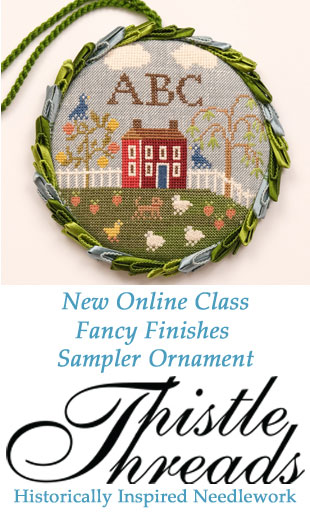



I’m enjoying this series on silk threads, Mary. I purchased a variety of silk threads a few months ago, and I’m eager to learn more before I start stitching with them. Perfect timing. Thanks.
Thank you so much for this comprehensive, insightful and inspiring piece…my stitcher’s neuro-networks wake up and engage just reading it. Off to explore my silk filament stash with new eyes 🙂
As usual, you are most gracious and generous in spreading a little love with your wealth of knowledge. What a great article! i learn so much from you, thank you!
If you are going to work and play with mulberry silks, from the UK, you may want to take a look at Pipers Silks, also from the UK. I have used their floss, the twisted spun silks and the gimp weight threads. They dye their silks in the UK. The floss is closer to that of filament silks. Not sure if you are including this product line in your review. Helen Stevens uses Pipers for her painted pictures.
Enjoyed the article.
Hi,Dianne – yes, I have Piper’s on the list for flat silk, which is what Helen uses.
You have no clue how much I needed this. I just started stitching this orphanage Sampler using Paris silks. They’ve been a nightmare splitting etc. I’m going to try smaller strands. http://www.theessamplaire.com/browse.php/detail/58
Dear Mary
I’m really enjoying your articles on silk thread especially explaining the difference between spun and filament silk threads. It’s really useful to know the difference between silk threads and how to use them in embroidery. I have in my stash various Au Ver a Soie silk threads and after I finish my current project I plan to do some experiments with different threads, especially the silk threads that I have in my stash which I have not used. So I can look at your articles and see which silk threads fit with different stitches. So Thanks for sharing these invaluable articles with us and for your tips and techniques and resources where we can purchase them. I do hope you have a great weekend.
Regards Anita Simmance
Several members of our guild are using Piper Silk from U.K. For Helen Stevens’s One Stitch pieces. Beautiful spun silk looks similar to Mulberry silk. Only problem is working with rough skin on hands, so sugar and olive oil scrub a must before stitching.
Hi, CJ – Pipers that Helen uses is a flat filament silk…I’ll be talking about that one next week! 🙂
Um… does filament silk make anyone else feel a little queasy? This might be awkward to talk about, but it’s made from an unbroken cocoon with a little animal in there that they must kill first. I’m not a vegetarian or vegan, though my mother and several family members are, but this bothers me. A cocoon is supposed to be safe. We even use the word to describe cozy places in our homes. And this particular caterpillar builds such a good and strong cocoon for itself that it has been killed for it over countless years. The little creature has been domesticated actually, and the moths that are allowed to emerge from the cocoon (for breeding purposes, I believe) don’t have the ability to fly or feed themselves.
My feelings about all this can be put plainly: cocoons should be safe and the domestication has had devastating effects to the species. This is why the talk of silk threads, especially filament silk, makes me uncomfortable. I loooooove embroidery and my favorite is needlepainting. These threads would really add quite a lot to my projects and a large part of me wants to use them (needs to!), but it just bothers me too much.
Argh.
The silk industry actually ‘farms’ these – breeds and raises them – so it isn’t really making the species unsustainable. It’s like farming any animal, really, that is used for consumption in one way or another.
It isn’t that the species is unsustainable, it’s more about what the farming has done to them. I’m more concerned about how breeding them has affected the species, about how the gifts nature gave them are being taken away. It just seems wrong, on a gut level. There are wild moths of the same species (or the closest to) of domesticated silk moths. If you were to compare specimens of each, I think it might be easier to understand what I’m trying to convey.
Anyway, I was just curious if this bothered anyone else.
I taught textile production
and history at an art college back East. If you think about it the crysalis does the work it was intended to do. when it’s own
coccoon is completed it
atrophies, or dries up. That
is it’s cycle of life. “and so it goes, and so it goes”.
And some of those threads come on those wonderful cat toys!! Since I quilt, and I use Mettler threads, I have those things littering my floor. Empty ones. So much fun to knock around.
Thank you so much for this comprehensive series on silk threads, and your careful and detailed explanations. Do you have a potential ebook or booklet here?
I was going to say that the articles are a tremendous resource for stitchers, but perhaps it is you, Mary, that fits that description best. I love your posts that contain multiple links to other articles – I can get lost down that rabbit hole without a second thought for time management! 🙂
I’ve used The Silk Mill threads and was very happy with how they stitched. The color selection can’t be beat either.
Pipers Silks in the UK do, I think, all 3 types and are very affordable.
I’m not sure where Madeira 4 stranded solk fits into the continuum, but they’re lower lustre, but also very affordable.
Those are the two brands I use, although I normally work with cottons as I prefer plant fibres ethically. 🙂
Have really enjoyed this week’s silk articles. I love stitching with silk! It is also my favourite thread for bobbin lacemaking too. I recently bought my first Silk Mill skeins, and when they arrived (super fast all the way from France, with very little postage charged too, win-win!), a pkt of Thread Heaven was included, with the recommendation that the silk be waxed before use. I wax some of my other threads ie couching thread when working with metal, but I’ve not heard of a need to wax silk before. Do you have an opinion on this?
Oh Mary, those Mulberry Silk packs of connoisseur thread are absolutely beautiful. Sky, Sea, Shrubbery, Gold Works, Blackworks…..So beautiful, but I could not find anything on their site regarding washability.
Do you know if they can be laundered?
Hi, Holly – gosh, I’m not sure. I haven’t tried! But you can definitely contact them – there’s contact info on their website. I’d love to know, too!
The only silks I tried and find accessible and affordable – Dmc satin and Anchor Marlitt – you haven’t mentioned….perhaps they’re flat filament silks…
Well, shiny they are, but tricky to work with…
And what matters most to me – both are washable. I find all the hand-dyed fancy (and overpriced) threads that can’t take some soap and water pretty useless (in the long run)
Hi, Lily – Thanks for your comment! DMC satin and Anchor Marlitt are both rayon (viscose) threads. They are shiny, but they aren’t actually silk. There are many differences between silk and rayon. Surprisingly, filament silk is actually stronger than rayon. Also, rayon (viscose) threads have a low retention of stability and appearance when wet. They can change appearance and lose their sheen to a degree, when they’ve been washed or steamed. They also have the lowest elasticity recovery of any fiber. When it comes to stitching, there are some applications that DMC satin and Anchor Marlitt work great with, but there are others they don’t work so well with. For example, long and short stitch shading. They just don’t have the right kind of “spread” that makes a smooth transition between threads in shading. I think they’re interesting threads to work with for some applications, though, and I’m glad you enjoy them and find that they work well for you, especially with washable items! I’ll have to look into them for that – it opens up some great possibilities! You’re absolutely right about most hand dyed over dyed threads – they aren’t suitable for washing. Also, depending on the dye process, some over-dyed threads, even when claiming to be colorfast (usually, this refers to getting wet) are not necessarily as “light fast” as other threads. They may fade faster than other threads. Thanks again for your comment and input!!
Thank *you*, Mary 🙂
I was just thinking out loud… I’m glad you corrected me, I was under misapprehension about Satin and Marlitt threads. It is good to learn these little details about manufacturing from your articles…
I haven’t worked much with these. but I thought it would be nice to have some basic colours in my collection; they have their uses… I still need to explore however. Never tried them in surface embroidery, only in counted
Please , i am french can you install google traduction in your blog ?
Hi, Veronique – If you go to Google Translate https://translate.google.com and put the website address in the box it will translate the whole website for you. Hope that helps!
This information is fascinating, I had no idea there was so much variety when it came to types of silk thread and how they can be used. I will be very interested to see the stitch samples you mentioned and learn about how the threads behave. My question: Would you mind showing how to open up and deal with the twisted skeins of thread you mentioned? I’m finding that rather daunting as when I’ve attempted it in the past my thread has ended up in a horrible tangled mess! I’d love to know how to avoid that. Thank you. 🙂
Hi, Kathryn! I’ll see what I can come up with for you! Yes, they do end up being a bit of a bear when they get out of hand!
Thank you Mary, that would be wonderful! Sending warm wishes from sunny Wales. 🙂
Hello all I would also be interested in opinions re michelle L comment about whether to wax silk or not. Thanks in advance
I am learning a lot from this conversation! I always use de Vere silks (UK) after finding them in a conservator’s studio and then when making a Sweet Bag with Jacqui Carey and Jane Lemon. In my opinion they are the nearest to the threads in ‘Elizabethan’ embroidery. Meredith Willett taught me how to strip them and reassemble to make a very subtle colour change akin to soft shading. Alison Cole is using them to make Shakespeare’s cap. They are NOT easy to use and are not a novice thread but the colours and very slight twist are true to the original articles we study. I love running Retreats with other needlework tutors as we discuss just this sort of subject in depth. Thank you Mary, for your wonderful article, we now have even more to discuss!
This is fantastic! I wonder if the next series will talk about the silks from the Japanese Embroidery Centre in the USA?
If I separate 12 ply silk in separate threads will the color be different then if I pulled 6threads and did not separate. I am having a hard time the color looks different when I started I just pulled 6 and did not separate. Then I started to separate each thread.
Thanks so much for this invaluable information. I’ve used AVA 100/3 and love it.
I’d like to print out this information for future reference.
I’m reading your articles on silk floss with pleasure. Thank you so much!
I’m researching silk floss because, after embroidering with cotton floss my entire life, this year (2020) I want to try stitching with silk. I’ve been afraid to try it, partially because silk floss is so expensive, but if not now, when, right?
Hello Mary, I came back to embroidery after studying for both my BA and MA from 2009 to 2017, then caring for my husband, who died in 2017 not long after I got my Master’s. (I’m only just on the right side of 74). I really enjoy your blog. I did wonder if you had put all these ones, relating to silk embroidery into one book? I get so involved in picking up the links and going from page to page that I sometimes forget where I came in (could be an age thing!). I’ve just invested £200+ in silk threads and am working on a decorated initial for my daughter’s 50th birthday in October. I’m struggling a bit with technique, it’s quite a long time since I’ve used pure silk threads on silk fabric, so could really use some good advice that is easy to find. I’ve ordered your e.book about plaited braid stitch which I have tried recently – it’s on one of Philippa Turnbull’s kits – and I think I’ve cracked it. I did a few trial runs using different thread including some Caron Watercolours. It would be great to have an e.book on using silk thread. Yours aye, Anne Cleave on the beautiful Isle of Mull.
My question is about the lining attached to the back of a satin or silk material that is being stitched. It seems that no matter how thin the backing material; when I iron it to the silk or satin material, there are bubbles or it just looks awful. What do you recommend to add body & stability to our silks & satins material. And do you need the backing when stitching with silk thread? Thank you, Nancy
Hi there – with hand embroidery, you don’t normally adhere backing fabric with fusible interfacing or anything similar. You simply mount the backing fabric in the hoop or on the frame at the same time as the ground fabric. You stitch through both layers. And that’s it!